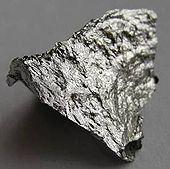|
|
| Manganese is a pinkinsh-gray, chemically active element. It is a hard metal and is very brittle. It is hard to melt, but easily oxidized. Manganese is reactive when pure, and as a powder it will burn in oxygen, it reacts with water (it rusts like iron) and dissolves in dilute acids. Applications Manganese is essential to iron and steel production. At present steel making accounts 85% to 90% of the total demand, most of the total demand. Manganese is a key component of low-cost stainless steel formulations and certain widely used alumimum alloys. Manganese dioxide is also used as a catalyst. Manganese is used to decolorize glass and make violet coloured glass. Potassium permanganate is a potent oxidizer and used as a disinfectant. Other compound that find application are Manganese oxide (MnO) and manganese carbonate (MnCO3): the first goes into fertilizers and ceramics, the second is the starting material for making other manganese compounds. |
http://www.lenntech.com/periodic/elements/mn.htm
